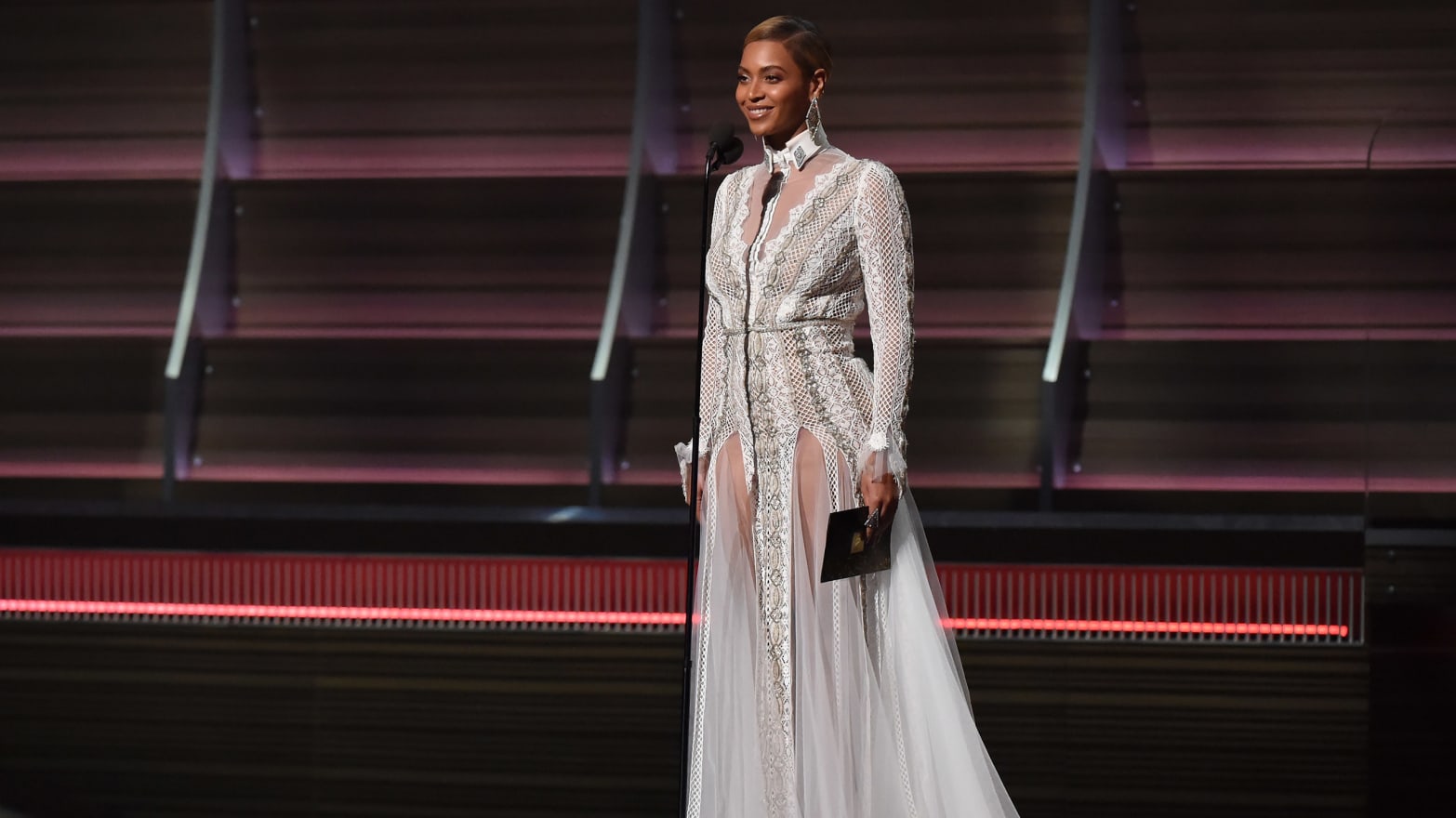When Beyoncé strutted on to the Grammy’s stage in February, fans went wild, and not just because her appearance was a surprise.
In true Queen B fashion, she made a show-stopping entrance in a stunning white lace gown that just happened to be a wedding dress by designer Inbal Dror.
It was feminine, yet sexy, with sheer fabric and a high collar that flirted with her décolletage, while parallel thigh-high slits left little to the leggy imagination.
It had a whiff of the Victorian, but still, in one look, perfectly summed up our modern lace infatuation.
“We had just released the ‘Formation’ video, and if you see the ‘Formation’ video, there’s a sort of Antebellum, Victorian vibe that kind of runs through the whole video,” Marni Senofonte, Beyoncé’s stylist, told The Daily Beast. “That dress just embodied it and was also super sexy at the same time. She looked at it, and it was just perfect for the moment.”
Senofonte has played with the juxtaposition of making the feminine fabric edgier both in the mix of looks Beyoncé wears—she’s a Michael Jackson-inspired Black Panther one week, a delicate and sexy Victorian-inspired queen the next—but also within a single look itself.
For one of Beyoncé’s tours, Senofonte made lace football jerseys with long trains for the dancers to wear.
“[Lace] is always a symbol of femininity, but you can just use it in so many different ways,” Senofonte said. “It just doesn’t have to be a dress. B wears lace overalls. I love bringing lace into the most masculine [things], like a sweatshirt, a football jersey, a hockey jersey. It really makes something so rough [have] a gentle touch.”
Over the past several years, lace has exploded on the runways and streets with an ephemeral vengeance.
It’s still the traditional fabric of Queen Victoria’s cavernously prude frocks, but, today, most designers and fashionistas use it as more of a canvas on which to play with the high-low mix of cutting-edge formalwear and combining masculine and feminine styles.
Also, it’s inherently sexy, with a peek-a-boo nature that many style stars love to exploit, especially in this spring’s latest look: white lace dresses.
In the past few months, Rooney Mara shined in a white lace Givenchy gown at the Oscars; Olivia Wilde turned up to Unite4:Humanity gala in Beverly Hills in an intricately laced Elie Saab number; Cate Blanchett wandered the streets of New York in a white lace Jonathan Simkhai dress for her Carol press tour; and Jessica Alba donned a flirty spring dress from Brock Collection for an event for her Honest Company.
Even reality stars are getting in on the action. It may have been a controversial season for The Bachelor, but winner Lauren Bushnell looked indisputably stunning when she showed up to the after-show in a sexy white lace mini dress.
In last week’s Vanderpump Rules finale, the episode’s centerpiece party featured all the warring lady leads, still with daggers drawn, all dressed in floaty lace.
Today, lace is the fabric of femininity, but that wasn’t always the case. Like most high-fashion styles, centuries ago, lace was known more for its aristocratic connotations than a gender-specific trend.
As far back as the 16th century, “lace ruffs and lace cuffs and lace collars” were seminal features of the high class, according to Valerie Steele, director of the Museum at the Fashion Institute of Technology. Two centuries later, that began to change.
“It’s really in the end of the 18th, early 19th century that a lot of things that initially read as aristocratic and luxurious, such as lace, color, jewelry, and embroidery, became re-imagined as feminine rather than aristocratic,” Steele told The Daily Beast.
“You no longer see men wearing pink silk suits with floral embroidery and lace cuffs. Prior to that, there was nothing feminine about it particularly. It was aristocratic. But then that got re-interpreted as feminine.”
While there were still fashion renegades (think Jimi Hendrix in the 1960s or Marc Jacobs wearing a lace dress to the Met Gala in 2012), for the past century lace has primarily been the purview of the ladies. It’s the stuff of lingerie and wedding gowns, feminine frocks and evening wear.
One of the catalysts for its latest resurgence was the Prada Fall/Winter 2008 collection. At her Milan show that season, Miuccia Prada sent a collection down the runway in which lace took center stage in a variety of patterns, colors, and combinations.
Prada reimagined the possibilities for the intricate fabric and “highlighted lace in a new way that made it look very modern,” Steele said.
“Miuccia Prada turned lace into a holy and fetishistic enterprise,” Cathy Horyn wrote in her New York Times review of the show.
Lace was high fashion in the days of Marie Antoinette, traditionally regal when worn by Queen Victoria, and feminine and a touch rebellious as hems crept up during the era of the 1920s flapper. At Prada’s 2008 show, it was being redefined as erotic and feminine for women of the 21st century.
In her review, Horyn wrote that “Lace is the fabric of women’s lives, from christening robes to bridal gowns to widow’s weeds.”
In their past two collections, Rodarte—helmed by Kate and Laura Mulleavy--has experimented with new ways to style and design with lace.
The label’s Spring 2016 collection, in particular, was inspired by poets and poetry and relied heavily on lace to tell this story.
“There were so many layers of lace and I guess the only way I could think about the way poetry is interesting is there’s so many layers to it that you decode through time or what you’re feeling or what you understand that someone is writing. And I guess that’s what we did,” Laura Mulleavy said in a video for Vogue.
If lace is having a regal renaissance now, fashion’s fickleness means it may be dethroned soon. But don’t expect it to fully fall out of favor: It has endured for hundreds of years, after all.
“Fashion is all about change, so if it’s in this season, it’s likely to be out if not next season than the season after,” Steele said. “But that’s just the nature of the beast. But, almost certainly, lace will come back again. It’s just such a unique and beautiful decorative device. In some form or another, it’s going to stay here.”

